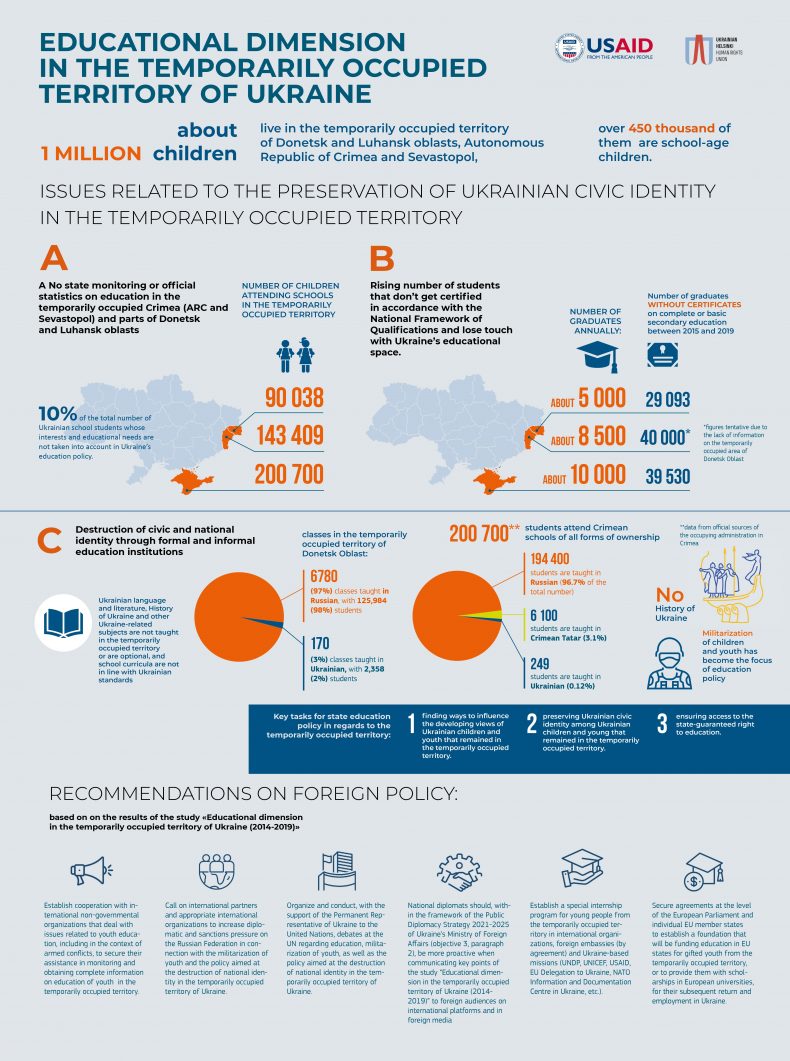Executive Summary of the Analytical Report “The Situation in the Educational Sphere in the Temporarily Occupied Territory of Ukraine”
02.03.2021
The Ukrainian Helsinki Human Rights Union would like to introduce at your attention an analytical report shedding a light on the situation in the sphere of formal and non-formal education in Ukraine’s temporarily occupied territory of Donbas and Crimea.
The right to education plays an important role in the system of human rights. One of the guarantees for this right, provided by domestic legislation as well as international standards in the field of education, involves positive obligations of a state. However, Russia’s armed aggression has been hindering Ukraine’s ability to ensure observance of this right in the temporarily occupied territory.
About one million children currently live in the temporarily occupied areas of Donetsk and Luhansk oblasts as well as the Autonomous Republic of Crimea and Sevastopol, including over 400 thousand school-age children. Although under international humanitarian law it is the occupying power’s duty to provide children with school education, the question arises as to whether a state may forsake its own obligations in this regard.
Analyzing the state of education of children and youth under occupation in 2014-2019, we can isolate at least three main aspects illustrating the need for working out state policy on education in the non-government controlled areas:
• the possibility of influencing the worldview of Ukrainian children and youth in the temporarily occupied territory;
• the possibility of helping Ukrainian children and youth in the temporarily occupied territory to preserve their Ukrainian identity;
• the possibility of ensuring access to the state-guaranteed right to education.
Key takeaways of the study:
• In the temporarily occupied territory, through its formal and informal education institutions, the occupying power is deliberately enacting a policy aimed at destroying the civic and national identity of the local population, done in the field of education for children and youth through militarization and restricted access to their national culture. Ukrainian language and literature, history of Ukraine and other related subjects are either not taught in the temporarily occupied territory at all or are optional, and school curricula are not in line with Ukrainian standards;
• Ever since the outset of the temporary occupation of parts of Ukraine, it has no official platform for collecting data regarding the educational field of Donbas and the occupied Crimea. All such monitoring is done by NGOs and is not systematic;
• General secondary education institutions in the temporarily occupied territory have 434,147 students, which, considering the corresponding figure for Ukraine (3,911,848 students in 2018), amounts to over 10% of Ukrainian pupils whose interests and educational needs are not taken into account in Ukraine’s education policy;
• 6 years of occupation saw a significant increase in the number of students without certification on their level of education under the National Qualifications Framework (basic secondary education, special secondary education). In particular: certificates of complete general secondary education – 117,500; certificates of basic secondary education – about 108,000;
• The absence of documents confirming a person’s education makes it difficult for graduates from the temporarily occupied territory to be part of Ukraine’s educational space and could prove an additional burden on Ukraine’s state institutions during the transition period after the temporarily occupied territory is reclaimed.
The following recommendations were formulated based on the study:
1. Step up political, legal and diplomatic efforts to uphold the right to education of the residents of the temporarily occupied parts of Ukraine; bring up this issue in negotiations; communicate it to the international community and make use of international legal mechanisms.
2. Improve coordination of all stakeholders, including central and local executive bodies, local governments, NGOs as well as international and national humanitarian and development partners, in their efforts to find long-term solutions for the protection of the right to education and to determine criteria for evaluating the progress of such solutions.
3. State authorities should create appropriate conditions for ensuring the right to education of the residents of the temporarily occupied territory.
More details of The executive summary of the analytical report are available here. The full report in Ukrainian is available here.
This analytical product was made possible by the generous support of the American people through the United States Agency for International Development (USAID) in the framework of the Human Rights in Action Program implemented by the Ukrainian Helsinki Human Rights Union.
USAID is the world’s premier international development agency and a catalytic actor driving development results. USAID’s work demonstrates American generosity, and promotes a path to recipient self-reliance and resilience, and advances U.S. national security and economic prosperity. USAID has partnered with Ukraine since 1992, providing more than $3 billion in assistance. USAID’s current strategic priorities include strengthening democracy and good governance, promoting economic development and energy security, improving health care systems, and mitigating the effects of the conflict in the east. For additional information about USAID in Ukraine, please call USAID’s Development Outreach and Communications Office at: +38 (044) 521-5753. You may also visit our website: http://www.usaid.gov/ukraine or our Facebook page at https://www.facebook.com/USAIDUkraine.
If you find an error on our site, please select the incorrect text and press ctrl-enter.
